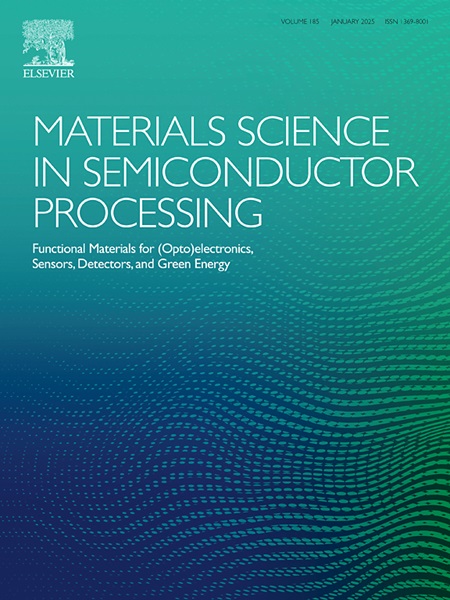探索末端封端分子对噻唑并[5,4-d]噻唑类化合物光伏特性的影响:DFT/TD-DFT 方法
IF 4.2
3区 工程技术
Q2 ENGINEERING, ELECTRICAL & ELECTRONIC
引用次数: 0
摘要
非富勒烯受体型有机太阳能电池(NFA-OSCs)具有未融合的中心核,近年来保留了显著的光电特性。本文以 TCTR 为参照物,设计了八种新的衍生物(TCTD1-TCTD8),以揭示它们的光伏和光电特性。在 TCTR 的两个末端用不同的独特苯并噻吩基受体进行了结构调整。随后,利用 DFT/TD-DFT 方法进行了各种分析,如前沿分子轨道(FMO)、状态密度(DOS)、紫外可见光谱、过渡密度矩阵(TDM)、结合能(Eb)、开路电压(Voc)和空穴电子研究。FMOs 和紫外-可见光谱的研究结果表明,与 TCTR(分别为 2.29 eV、715.26 和 668.52 nm)相比,新设计的化合物在氯仿溶剂(702.30-753.06 nm)和气相(655.72-695.84 nm)中显示出相似的带隙(2.13-2.32 eV)和浴色偏移。TDM 图、DOS 图和空穴-电子图表明所有衍生物都具有良好的电荷转移(CT)和激子解离特性。通过供体聚合物(PBDB-T)计算了它们的 Voc 值,得到了显著的结果(1.34-1.67 V)。在上述所有衍生物中,TCTD7 的带隙(2.13 eV)最小,λmax(在氯仿溶剂和气体中分别为 753.06 和 695.84 nm)和 Eb(0.49 eV)值最高。这些结果表明,该化合物(TCTD7)的激子解离率更高,从而实现了高效的光伏响应。理论研究表明,新设计的未熔合 NFA 具有独特的性质,有助于实验人员利用它们合成高效的光伏材料。本文章由计算机程序翻译,如有差异,请以英文原文为准。
Exploring the influence of end-capped moieties on the photovoltaic properties of thiazolo [5,4-d] thiazole based compounds: DFT/TD-DFT approaches
Non-fullerene acceptors-based organic solar cells (NFA-OSCs) with unfused central cores retain significant optoelectronic features in recent years. Herein, eight new derivatives (TCTD1–TCTD8) were designed from TCTR reference to enlighten their photovoltaic and optoelectronic properties. The structural modulation of TCTR is performed at its both terminal ends with different unique benzothiophene based acceptors. Following this, the DFT/TD-DFT methods were accomplished to perform various analyses such as frontier molecular orbitals (FMOs), density of states (DOS), UV–Vis spectra, transition density matrix (TDM), binding energy (Eb), open circuit voltage (Voc) and hole-electron investigations. The findings of FMOs and UV–Vis revealed that the newly designed compounds showed comparable band gaps (2.13–2.32 eV) with bathochromic shifts in both the chloroform solvent (702.30–753.06 nm) and gas phase (655.72–695.84 nm) as compared to TCTR (2.29 eV, 715.26 and 668.52 nm, respectively). The TDM, DOS and hole-electron plots represented the good charge transfer (CT) and exciton dissociation in all the derivatives. Their Voc was calculated via the donor polymer (PBDB-T) and significant results were obtained (1.34–1.67 V). Among all the afore-mentioned derivatives, TCTD7 exhibited the least band gap (2.13 eV), highest λmax (753.06 and 695.84 nm in chloroform solvent and gas, accordingly) and Eb (0.49 eV) values. These results illustrated the greater rate of exciton dissociation which led towards efficient photovoltaic response in the compound (TCTD7). The theoretical study marked the unique properties of newly designed unfused NFAs which aid the experimentalists in their utilization for synthesizing efficient photovoltaic materials.
求助全文
通过发布文献求助,成功后即可免费获取论文全文。
去求助
来源期刊

Materials Science in Semiconductor Processing
工程技术-材料科学:综合
CiteScore
8.00
自引率
4.90%
发文量
780
审稿时长
42 days
期刊介绍:
Materials Science in Semiconductor Processing provides a unique forum for the discussion of novel processing, applications and theoretical studies of functional materials and devices for (opto)electronics, sensors, detectors, biotechnology and green energy.
Each issue will aim to provide a snapshot of current insights, new achievements, breakthroughs and future trends in such diverse fields as microelectronics, energy conversion and storage, communications, biotechnology, (photo)catalysis, nano- and thin-film technology, hybrid and composite materials, chemical processing, vapor-phase deposition, device fabrication, and modelling, which are the backbone of advanced semiconductor processing and applications.
Coverage will include: advanced lithography for submicron devices; etching and related topics; ion implantation; damage evolution and related issues; plasma and thermal CVD; rapid thermal processing; advanced metallization and interconnect schemes; thin dielectric layers, oxidation; sol-gel processing; chemical bath and (electro)chemical deposition; compound semiconductor processing; new non-oxide materials and their applications; (macro)molecular and hybrid materials; molecular dynamics, ab-initio methods, Monte Carlo, etc.; new materials and processes for discrete and integrated circuits; magnetic materials and spintronics; heterostructures and quantum devices; engineering of the electrical and optical properties of semiconductors; crystal growth mechanisms; reliability, defect density, intrinsic impurities and defects.
 求助内容:
求助内容: 应助结果提醒方式:
应助结果提醒方式:


